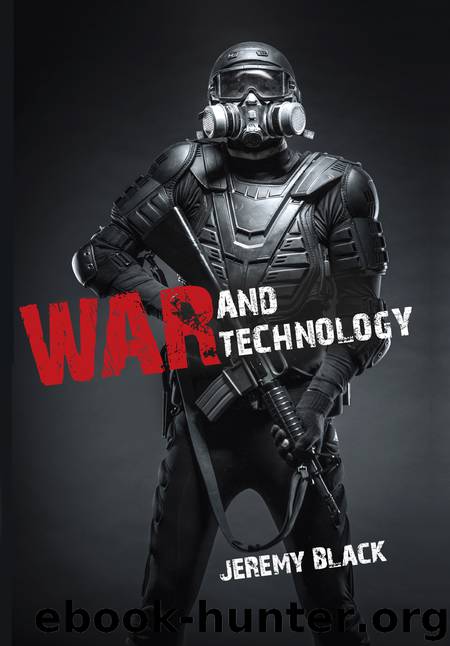War and Technology by Jeremy Black

Author:Jeremy Black
Language: eng
Format: epub
Publisher: Indiana University Press
Published: 2013-03-16T16:00:00+00:00
POST-1945
Tanks were not suited to or available for many of the conflicts that followed 1945. Revolutionary forces tended not to have any, while the terrain and vegetation of the areas in which they operated were often not well suited to tanks. This was the case, for example, with the Viet Minh’s campaigns against the French in Indo-China in 1946–1954, campaigns that largely focused on the heavily wooded interior of North Vietnam, notably in the Dien Bien Phu operation of 1953 in which French troops parachuted into a valley were successfully outgunned by Viet Minh artillery and overrun by infantry attacks. In 1959, Allen Dulles, the director of the CIA, explained to the American Senate Foreign Relations Committee that in Cuba “what you need against guerrillas are guerrillas. . . . It is rough country, and there is no use sending tanks and heavy artillery up there.”21 The Batista government had fallen there at the start of the year to Fidel Castro’s left-wing guerrilla-style insurrection, without the Americans intervening. There was also the problem—which affected, for example, the combatants in the Arab-Israeli war of 1948–1949—that the major powers that manufactured tanks were not necessarily willing to supply them to other states.
However, the situation in the Middle East was very different by the time of the next Arab-Israeli war, in 1956 between Egypt and Israel, in large part because the diffusion of advanced weaponry became a way to obtain, secure, and support protégés. In 1955, the Soviets, through Czechoslovakia, agreed to provide hundreds of tanks, 200 MiG-15 fighters, and 50 Ilyushin-28 bombers to Egypt. In contrast, France, then, because of its endangered colonial position in Algeria, opposed to the pan-Arab nationalism of Colonel Nasser of Egypt, armed Israel.22 In 1965, concerned about rising Soviet influence in Egypt, President Lyndon B. Johnson agreed to sell tanks to Israel. The rivalries of the Cold War thus ensured the spread of technology even as patrons and protégés changed. American support for Israel replaced that of France. Arms supplies were not only the case with the Arab-Israeli struggle. In 1978, Soviet-supplied tanks helped Ethiopia defeat Somalia. The variety of sources of supply was indicated by the Pakistani air force in 1971, which contained American and French planes as well as Chinese-built MiG-19s and planes that had originally belonged to the German Luftwaffe.
At the same time, the confrontation between the Soviet-led Communist bloc and the American-led West for long focused on Europe, where their land forces were massed and faced each other across the border between West and East Germany. As a result, the North European Plain appeared the clear cockpit of any future war, with planning accordingly,23 and this encouraged an emphasis on tanks by both sides and the related development of armor-based doctrine.
Tank attacks were regarded as the key means by which the Red (Soviet) Army would advance: the Soviet Union had a major advantage in tank numbers as well as considerable experience from the Second World War. In response, NATO countries sought to deploy
Download
This site does not store any files on its server. We only index and link to content provided by other sites. Please contact the content providers to delete copyright contents if any and email us, we'll remove relevant links or contents immediately.
Whiskies Galore by Ian Buxton(41888)
Introduction to Aircraft Design (Cambridge Aerospace Series) by John P. Fielding(33064)
Small Unmanned Fixed-wing Aircraft Design by Andrew J. Keane Andras Sobester James P. Scanlan & András Sóbester & James P. Scanlan(32744)
Craft Beer for the Homebrewer by Michael Agnew(18146)
Turbulence by E. J. Noyes(7943)
The Complete Stick Figure Physics Tutorials by Allen Sarah(7312)
Kaplan MCAT General Chemistry Review by Kaplan(6868)
The Thirst by Nesbo Jo(6834)
Bad Blood by John Carreyrou(6559)
Modelling of Convective Heat and Mass Transfer in Rotating Flows by Igor V. Shevchuk(6392)
Learning SQL by Alan Beaulieu(6214)
Weapons of Math Destruction by Cathy O'Neil(6152)
Man-made Catastrophes and Risk Information Concealment by Dmitry Chernov & Didier Sornette(5926)
Digital Minimalism by Cal Newport;(5670)
Life 3.0: Being Human in the Age of Artificial Intelligence by Tegmark Max(5479)
iGen by Jean M. Twenge(5368)
Secrets of Antigravity Propulsion: Tesla, UFOs, and Classified Aerospace Technology by Ph.D. Paul A. Laviolette(5311)
Design of Trajectory Optimization Approach for Space Maneuver Vehicle Skip Entry Problems by Runqi Chai & Al Savvaris & Antonios Tsourdos & Senchun Chai(5012)
Pale Blue Dot by Carl Sagan(4917)
